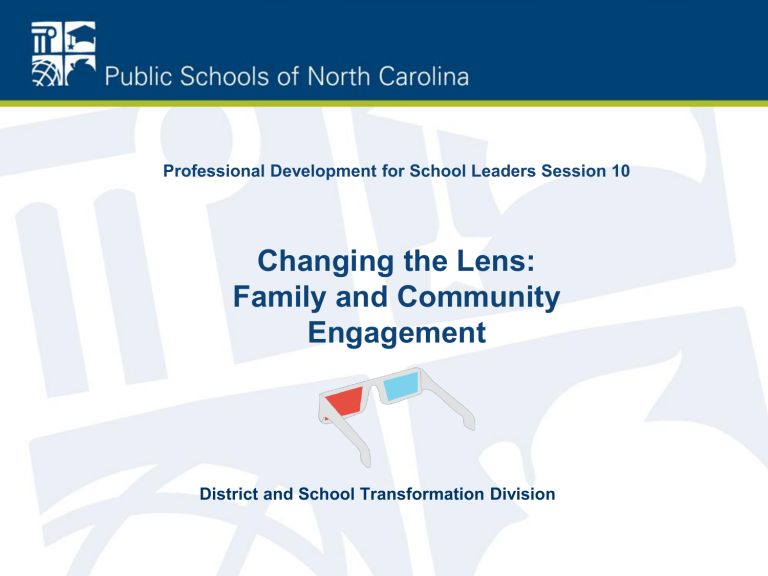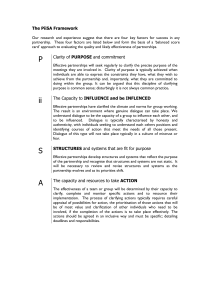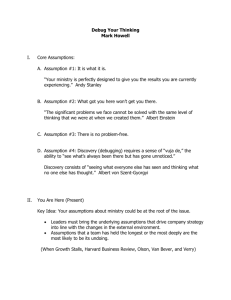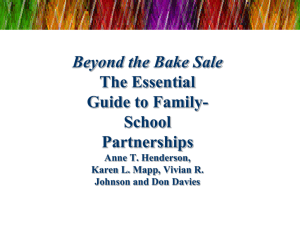School Culture and Family/Community Engagement

Professional Development for School Leaders Session 10
Changing the Lens:
Family and Community
Engagement
District and School Transformation Division
Introductions
Outcomes
Participants will:
• identify and assess current family and community involvement activities/initiatives;
• define, explore, and identify parent/community involvement versus school partnerships;
• work collaboratively to analyze attitudes, assumptions, and beliefs (underlying culture/root causes) that affect school partnerships; and
• consider how to make family and community involvement part of the ongoing curricular conversation.
A
ppreciation for one another
E
xchange ideas freely
I
nfluence what we can
O
pportunity to reflect
U
nite in purpose
Research says… when parents are enabled to become effective partners in their child’s education, performance in schools where children are failing improves dramatically.
Research says …
Schools that work well with families:
– outperform identical programs without parent and family involvement;
– have improved teacher morale and higher ratings of teachers by parents; and
– have more support from families and a better reputation in the community.
Research says…
The most accurate predictor of a student’s achievement in school is
not income or social status
, but the extent to which that student’s family is able to:
• create a home environment that encourages learning;
• communicate high, yet reasonable, expectations for children’s achievement and future careers; and
• become involved in children’s education at school and in the community.
Why all the Fuss?
When parents are involved, STUDENTS:
• achieve more, regardless of socio- economic status, ethnic/racial background, or the parents’ education level;
• have higher grades and test scores, have better
attendance, and complete homework more consistently; and
• exhibit more positive attitudes as well as decreased alcohol use, violence, and antisocial behavior.
Why all the Fuss?
Therefore, it is essential that we understand and find ways to incorporate families and communities into the educational journeys of our students.
Why all the Fuss?
*Standard II: Teachers Establish a Respectful
Environment for a Diverse Population of Students:
Teachers work collaboratively with the families and significant adults in the lives of their students.
• Improve communication and collaboration between the school, the home, and the community
• Promote trust and understanding and build partnerships with school community
• Seek solutions to overcome obstacles that prevent family and community involvement
Why all the Fuss?
Standard 6: External Development Leadership
The school executive practices effective external development leadership when he or she: other stakeholders to make significant decisions; stakeholders in a shared responsibility for student.
Family Engagement and Teachers
Improved family engagement…
- increases teacher moral;
- improves school culture; and
- improves relationships between students and teachers. http://www.youtube.com/watch?v=IHq4eliP63U
Activity: What we do now
• Consider and list all the ways families or community members are involved in, engage with, or interact in your school (from formal to informal, both group and individual interactions, either
“negative” or positive).
• Think about participation rates in each activity, in terms of the entire school population and specific parent groups.
• Determine if each activity is student centered, school centered, both, or neither.
Exploring Levels of Family and
Community Engagement
What is a Partnership?
“relationships between individuals or groups that are characterized by mutual cooperation and responsibility, as for the achievement of a specified goal”
(American Heritage® Dictionary, 2000)
Activity: What we do now revisited
• Reconsider the list of the ways families or community members engage at your school that you created earlier.
• Using the definition and indicators just described determine if each activity reflects the characteristics of a
“partnership” or “family involvement.”
Beyond Activities
Barriers to higher family participation rates and effective partnerships that directly relate to school culture
Families:
• lack confidence in their ability to contribute.
• lack knowledge about how the school system works.
• do not feel welcome in the school.
School Culture and Family/Community
Engagement
The culture of a school is at the core of the amount and frequency of family and community engagement.
Culture
Negative or chaotic cultures do not attract people.
Positive and systematic cultures draw people!
School Culture and Family/Community
Engagement
Perception is a key component to family and community engagement.
• How do those in the school every day view family and community groups?
• How do family and community groups view the school?
• What do each believe about family and community engagement?
Pulse Check: Core Beliefs About
Family/Community Engagement
1. What do I/we think about family/community engagement?
2. Will family/community engagement work at this school? Why or why not?
3. What is my/our role in promoting family/community engagement at our school?
4. Are we willing to devote time, resources, and energy to family/community engagement to bring about more achievement of my students?
Activity: Examining Assumptions,
Attitudes, and Beliefs
• Each statement on the left hand side of the handout is an assumption, attitude, or belief about family or community engagement.
• Working with your school group, read each of the statements in the box on the left hand side of the sheet and decide if the statement is an assumption, attitude, or belief held by anyone on your staff.
• If it is held by any staff member(s), identify the role and the percentage of staff who may hold this assumption, attitude, or belief .
• Identify and write down evidence that supports this and make a link to the impact of this assumption, attitude, or belief on student achievement, family or community engagement, or school culture.
Role Play
• Find a partner in the room.
• Together, choose one of the statements about family/community engagement.
• One of you will play the role of the principal and one of you will play the role of a staff member.
• Staff member – in the role play, express the attitude, assumption, or belief that you and your partner have chosen.
• Principal – it is your job to guide the staff member in changing their attitude, assumption, or belief if it is negative or, if the statement is positive, guide the staff member in taking that statement from an attitude, assumption, or belief to an action.
Debrief
• Is it important to address underlying assumptions, attitudes, and beliefs?
If so, why?
• Why can this be difficult?
• Were you able to lead the conversation forward towards some actionable steps? If so, how?
Where are we now?
Fortress to Partnership School
Where does YOUR school fall?
Activity: 4 Types of Schools
+
Student Achievement
-
Partnership
School
Open Door
School
Come-if-we-call
School
Fortress
School
•
• Consider the evidence you have gathered this morning (current activities, pulse check, and assumptions, attitudes, and beliefs).
Individually , review the rubric indicators. Based on the evidence, circle where you feel your school falls on the continuum with indicators for each category (Building Relationships, Linking to
Learning, Addressing Differences, Supporting Advocacy, and Sharing
Power).
Table Talk: Coming to Consensus
• Discuss which categories you felt you were stronger in and those you felt were the greatest areas for improvement.
• Now, as a school team, come to consensus about what type of school you have in terms of family and community engagement.
Partnership Open Door Come-if-we call
Fortress
Work Groups
When you return from break, please go to the area of the room that matches the colored dot you have.
Green-Sherry Yellow-Sharon
Blue-Ken Orange-Lucy
Break
http://linoit.com/users/smsilver1/canvases/F.A.C.E%20
Expectations for Work Groups
• Within each work group, we will explore core beliefs about partnerships.
• Based on where each group currently identifies itself, the group will explore areas for improvement and gaps between their ideals and reality.
• Each group will explore next steps.
Do we share these core beliefs?
All parents have dreams for their children and want the best for them.
All parents have the capacity to support their children’s learning.
Parents and school staff should be equal partners.
The responsibility for building partnerships between school and home rests primarily with school staff, especially school leaders.
How Do You Know If You Are Open to Partnerships?, Henderson, Anne T., Mapp, Karen L., 2010
Debrief: Personal Reflection
Write down one take-away from your work in the small group
(share with someone during lunch).
- What are your next steps to fill the gap between where you are now and stronger family and community partnerships?
Lunch
How do students’ developmental levels impact family engagement?
Activity: Student Voices
• What do students at each school level say about family engagement?
• How does this influence our planning to develop family and community partnerships?
“We must continually plan, monitor, and model the best behaviors and practices known. This will only happen if the process is cyclical, if it becomes internalized, if it is how we do business every day.”
DuFour, Eaker, & Ranells, 1992 p.11
Embedding Family and Community
Engagement into Professional Dialogue
• Embed ideas about family and community engagement into the ongoing dialogue within the school.
• Move beyond family and community engagement as stand-alone events only.
• Consider various levels of family/community involvement and differentiate based on the curricular unit/theme, family and/or community needs, and shared expectations.
Embed ideas about family and community engagement into the ongoing dialogue within the school.
During or before the end of every PLC ask:
• How can we involve parents and/or the community?
• How can parents and/or the community enhance this unit, lesson, activity, etc.?
• What level of engagement is appropriate at this point?
The chart on the next slide or the handout may help in guiding this discussion.
Levels of Family Engagement
Empowering
Participating Observing Responding Informing
Decision-making:
Parents and students meet with counselors for individual academic planning sessions, feel comfortable asking questions, and make informed choices about coursework.
Parents are active during SIT meetings and provide input and feedback on course offerings.
Parents help plan and organize, present during, or attend a college and career fair.
Parents come to school and watch their children give class presentations that relate to content they are studying and a potential career choice during a class.
Parents sign and send back students’ class schedules for the upcoming year and/or donate food items for an upcoming college and career fair.
Information about graduation requirements is sent home in a letter or a presentation is given on graduation requirements during a
PTA meeting.
Embed ideas about family and community engagement into the ongoing dialogue within the school.
The DuFour PLC Model
How can we infuse family and community into the dialogue?
1. What will students learn?
2. How will we know students are learning it?
3. How will we respond when they do not?
1. Do we have any family or community members with expertise or experience in this area (that can share or that we can reference)?
2. Can we gather family feedback on how successfully students are able to complete homework assignments?
3. Is there support families can offer at home? (What is a reasonable expectation?)
Empowering Families and
Communities
Words parents expressed when discussing their engagement in their children's schools
McDermott P., Rothenberg, Julie. (2000). Why Urban Parents Resist Involvement in their Children's Elementary Education. The Qualitative Report, Volume 5, Numbers 3 & 4.
Who is in this group?
“Family involvement in education is influenced by culture, income, language, and the adults' perceptions of school and family responsibilities.”
McCarthey, S. (2000). Home-school connections: A review of the literature. The Journal of Educational Research, 93, 145-153.
Family Structures
• Two-parent family in same home
with a stay at home parent
- with two working parents
• Two-parent family in different homes
• Blended family
• Single-parent family
• Extended family/Multi-generational family
• Adopted/foster family
• Students who are parenting
Activity: Table Talk
• Consider and identify all of the different family structures that exist in your school.
• Are all family structures valued the same within the school culture? Which may be undervalued? ( It may be helpful to refer back to the Assumptions, Attitudes, and
Beliefs handout ) .
Factors/Resources that Influence
Parent Visibility
Socio-economics
Education
Family structure
Culture
Employment
Health
What do you see?
Are some groups viewed as liabilities as opposed to assets to the school community?
What do you see?
If we can change the lens through which we view our least “active or visible” family/community groups, we may transform our school culture in a way that significantly improves family and community perception of us, and thereby, increase
and deepen engagement.
Poverty and Family/Community Engagement
• We cannot mistake lack of presence for lack of concern.
• Resources are limited – this will influence what engagement looks like.
• Glass half-full: In poverty, possessions are limited; therefore, in most family and community structures, people, particularly children, are highly-valued and cared about because this is the most consistent resource available.
Payne, Ruby .(2005). A Framework for Understanding Poverty. Fourth Revised Edition. Aha! Process Inc.
Culture and Family/Community Engagement
• Cultural differences between our schools and families are often underexplored and undervalued.
• In many ethnic cultural groups, extended family plays an essential role in day-to-day, family operations and is responsible for the care of all children within the family group.
• In many ethnic communities, there are shared values and history that links the families within it.
• Glass full: Some of our students have a network of familial support that can be incorporated into the school community.
The parent that never comes…
One of the deepest truths about the cry of the human heart is that it is so often muted, so often a cry that is never uttered. To be sure there are needs and feelings that we express quite openly; lying deeper are emotions we share only with loved ones, and deeper still the things we tell no one…It is strange that members of a species renowned for communicative gifts should leave unexpressed some of their deepest yearnings.
- John Gardner
Personal Reflection
Think about the quote from Gardner and how it relates to families that are not actively involved in your school.
What does this mean for students?
How does this impact our work towards nurturing family and community engagement?
What do ALL parents want?
All parents want their children to be happy, cared for, and safe, this is universal.
Research shows parents also want:
• Good communication skills
• RESPECT for their children and their families
• High expectations
McDermott P., Rothenberg, Julie. (2000). Why Urban Parents Resist Involvement in their Children's Elementary Education. The Qualitative Report, Volume 5, Numbers 3 & 4.
Break
http://linoit.com/users/smsilver1/canvases/F.A.C.E%20
Activity:
Post every word that comes to mind when you hear the word “advocacy.”
Advocacy
Advocacy
When parents advocate they:
- question;
- typically focus on the interest of
their
child and his/her learning;
- seek to be heard; and
- desire a resolution.
Advocacy
Schools that welcome parental advocacy:
• encourage and answer all questions;
• focus on the interest of the parents’ child and his/her learning, and keeps in mind the learning of ALL students as well;
• engage in collaborative dialogue versus
“silenced dialogue”;
• help clarify the issue/problem and work towards outcomes; and
• create an atmosphere of respect and understanding.
Advocacy
Confrontational
• Seeks only to be heard
• Seeks to identify the problem/blame
• Typically grows out of frustration
Developmental
• Seeks both to hear and be heard
• Seeks to understand the problem and then find a resolution
• Typically comes from a sense of empowerment
Underlying both is care and concern for a child.
Parent Empowerment
• We must empower parents without making the conversation a power struggle.
• When there is a power struggle the focus is not on students.
Empowering Families & Communities
• How one school is doing it (Stanton Elementary
School – Academic Parent Teacher Teams Video).
http://www.youtube.com/watch?v=1YNsWrFiYfY
• Use the observation sheet to capture evidence
(what parents or school staff are doing) and the potential impact on student learning, school culture, or family/community partnerships.
Empowering Families & Communities
Revisit criteria for a partnership versus parent involvement. Which criteria do the actions in the video meet?
The research is abundantly clear: nothing motivates a child more than when learning is valued by schools and families/community working together in partnership …These forms of [parent] involvement do not happen by accident or even invitation. They happen by explicit strategic intervention.
- Michael Fullan
What are we going to do?
Think about developing family and community partnerships strategically by...
• Identifying levels of resources and current family engagement for each student.
• Brainstorming and implementing strategies that will work best based on this identification.
• Making this process manageable – determine resources/ start with a few ( highest leverage points ) .
Follow-Up: What are we going to do?
You may request follow-up training for your staff, SIT, or other stakeholder groups based on your outcomes from today.
Culture for Learning
Cultural Responsivity
Changing the Lens: Family and Community Engagement (School-level)
Building Effective Partnerships
Creating More Productive Parent Meetings through Advocacy
*Training provided by District and School Transformation – Instructional Review
Coach Team
Family, Community, and Schools
“Let’s put our minds together and see what life we can make for our children.”
– Sitting Bull







